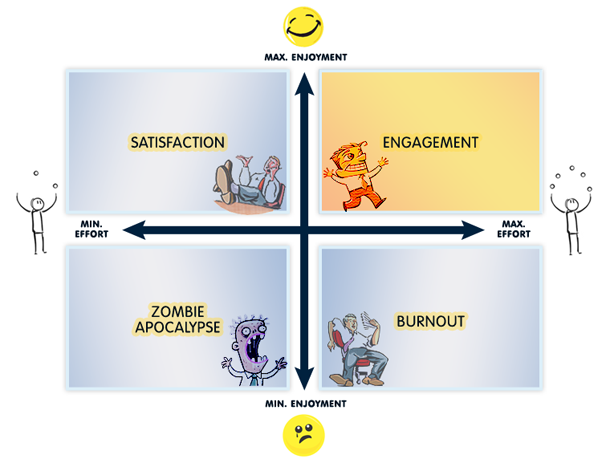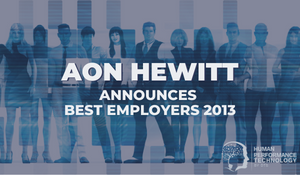A Simple Model of Employee Engagement
Back in 2013, we developed a model to help explain what engagement looks like and, in particular, how it differs from the likes of employee satisfaction. We call it the Effort-Enjoyment Model of Engagement.
Introduction to the Effort-Enjoyment Model of Engagement
It's a simple, 4-quadrant framework. Interestingly, it aligns with the definition of engagement from the Centre for Creative Leadership: “Engagement is defined as satisfaction with job and commitment to the organisation.”

When you decouple effort from enjoyment, you are left with a content worker who does not see the point in going the extra mile, and when you decouple enjoyment from effort, you are left with a hard worker who is dissatisfied.
The complete absence of both effort and enjoyment in the workforce leads you into the least desirable position within the four quadrants: the zombie apocalypse. It’s only when you combine effort and enjoyment together that you have the essential elements for engagement.
Engagement is not just about effort. Many employees work hard, long hours without any underlying sense of enjoyment in their work. In the short-term this will lead to stress, and over the long term this will lead to burnout.

Development of Our Model
The creation of the Effort-Enjoyment Model of Engagement was sparked by the following excerpt from a research article: “Researchers in burnout define employee engagement as the positive antithesis of burnout" (Maslach et al. 2001).
This is partly true, although it's not the full picture. If a fully engaged person is someone who loves his/her job and goes the extra mile, then a fully disengaged person is someone who hates his/her job, does as little as possible and acts as a destructive force within the business. In the engagement literature, this is sometimes referred to as a "toxic" employee, which we have named the zombie.
The zombie employee is the true antithesis of the engaged employee. Gallup would describe this group as the actively disengaged - those who are effectively undermining the business in which they work. This group currently makes up 14% of employees, compared to 36% of engaged employees, which is a ratio of 2.6-to-1 engaged to actively disengaged workers.
Another Notable Model

Another business-friendly model with similarities to our own is The X Model of Engagement (pictured above) by Blessing White, which is now GP Strategies. They describe full engagement as the intersection between maximum satisfaction and maximum contribution. This concept parallels our Effort-Enjoyment Model, although we discovered the creation of the Blessing White model actually pre-dates our own. (You can see that the models are essentially identical by rotating our model counter-clockwise until it resembles the letter "X.")
From our perspective, engagement features strong emotional connection, identification and commitment to one’s work and workplace (evident from high levels of discretionary effort) and personal satisfaction. Of course there are many other definitions of engagement! See our post: 25 Definitions of Engagement.
References
Jennifer Deal, Sarah Stawiski, & William Gentry. Employee engagement: Has it been a bull market? Centre for Creative Leadership (CCL), 2010.
Jim Harter. U.S. Employee Engagement Reverts Back to Pre-COVID-19 Levels. Gallup, 16 October 2020.
Blessing White. The X Model of Engagement, 17 October 2013.

Theo Winter
Client Services Manager, Writer & Researcher. Theo is one of the youngest professionals in the world to earn an accreditation in TTI Success Insight's suite of psychometric assessments. For more than a decade, he worked with hundreds of HR, L&D and OD professionals and consultants to improve engagement, performance and emotional intelligence of leaders and their teams. He authored the book "40 Must-Know Business Models for People Leaders."



We Would Like to Hear From You (0 Comments)